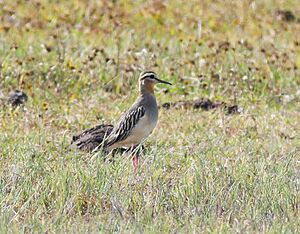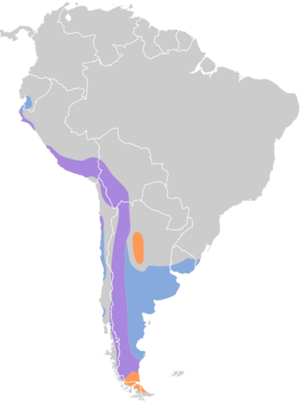Tawny-throated dotterel facts for kids
Quick facts for kids Tawny-throated dotterel |
|
|---|---|
 |
|
| Brazil | |
| Conservation status | |
| Scientific classification | |
| Genus: |
Oreopholus
|
| Species: |
ruficollis
|
 |
|
| Synonyms | |
|
Eudromias ruficollis (Wagler, 1829) |
|
The tawny-throated dotterel (Oreopholus ruficollis) is a special type of bird that belongs to the plover family, called Charadriidae. You can find this bird in several countries in South America, including Argentina, Bolivia, Brazil, Chile, Peru, and Uruguay.
Contents
About the Tawny-Throated Dotterel
What's in a Name?
The tawny-throated dotterel is the only living bird in its group, called a genus, which is named Oreopholus. There was once another species in this group, O. orcesi, but it is now extinct and only known from old fossils.
This bird has two main types, called subspecies. They are O. r. ruficollis and O. r. pallidus. Some scientists think these two types might be different enough to be studied more closely because their feathers look a bit different.
What Does It Look Like?
The tawny-throated dotterel is about 25 to 29 cm (9.8 to 11 in) long, which is roughly the length of a ruler. It weighs between 120 to 154 g (4.2 to 5.4 oz), which is about as much as a small can of soda.
Both male and female birds look the same, and their feathers don't change much during different seasons. Adult birds of the main subspecies have a rich, light brown color. Their backs have dark stripes. They have a white chin, an orange-brown throat, and a gray neck and chest. They also have a small black patch on their belly. When they fly, you can see their white feathers under their wings.
Younger birds have a lighter brown throat. Their backs have fewer stripes, and their undersides are paler with a brown belly patch. The O. r. pallidus subspecies looks very similar but is a bit smaller and lighter in color overall.
Where Do They Live?
Their Homes and Habitats
The O. r. pallidus subspecies of the tawny-throated dotterel lives in a small area. You can find it along the coast of northern Peru, reaching south to the Department of La Libertad. Sometimes, this subspecies has been seen in Ecuador, even though it doesn't usually live there. This is called being a vagrant.
The main subspecies, O. r. ruficollis, has a much larger home range. It lives from southern Peru, south through western Bolivia, Chile, and western Argentina. It goes all the way down to Tierra del Fuego and east through southern Argentina into Uruguay and southern Brazil. This subspecies has also been seen as a vagrant on the Falkland Islands.
Tawny-throated dotterels like to live in grasslands, heath shrublands, and open fields and meadows. The main subspecies can be found in the high puna areas of the Andes mountains, as high as 4,600 m (15,100 ft). The O. r. pallidus subspecies prefers the flat coastal areas of Peru.
How They Live
Their Journeys
The main subspecies of the tawny-throated dotterel breeds in the high Andes mountains. After the breeding season, they move to lower areas. Some even travel to the coast of Chile. Birds living in the far south migrate north into Argentina and sometimes even further into southern Brazil. The O. r. pallidus subspecies seems to stay in its small coastal area all year round.
What Do They Eat?
Scientists don't know much about what the tawny-throated dotterel eats or how it finds its food. However, it is known that during the non-breeding season, these birds often feed together in large groups, sometimes with as many as 100 birds!
Reproduction and Life Cycle
The nesting season for the tawny-throated dotterel seems to be from June to January. The exact timing can change a bit depending on where they live. The O. r. pallidus subspecies builds its nests on sandy soil close to the sea.
We don't know much about their nests, how many eggs they lay, how long the eggs take to hatch, or how long it takes for the young birds to be ready to fly on their own.
Their Calls
The tawny-throated dotterel doesn't make a lot of noise. When it flies, it makes a long, vibrating whistle sound that sounds like "prrrrruu." It also has a rhythmic call that sounds like "chup!-prri-rri-rruu." If it senses danger, its alarm call is a strong "chee!-chu-chup."
Their Status in the Wild
The IUCN (International Union for Conservation of Nature) has looked at the tawny-throated dotterel and decided it is a species of "Least Concern." This means it's not currently in immediate danger of disappearing.
Even though it lives in a very large area, scientists believe there are fewer than 6,700 adult birds left. This number seems to be going down. No major threats have been found right now. These birds live in several protected areas, which helps keep them safe. However, there is some concern that hunting during their fall migration could be a problem for them.


